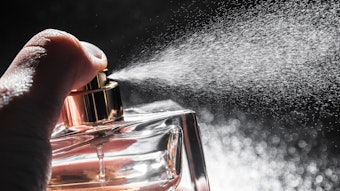Abridged from an article originally published in the July 2010 issue of Perfumer & Flavorist magazine.
“What is perfume?” is usually the very first question I like to pose to students on day one of a perfumery class. I encourage each one of them to answer the question, and the answers typically include one of these: Nice smell, mixture of odoriferous materials, mixture of natural and synthetic materials, a smell to invoke a feeling, a mixture of art and science, essential oils, fashion statement, something added to a product to give a nice smell, smell worn to attract a partner, the smell of a flower.
I cannot dismiss any of these answers as wrong; however, I suggest the Latin origins of the English word perfume, “per fumum,” which literally means “through smoke” and hints toward a more empowering meaning. “Through smoke” indicates perfume’s early use in offerings made to God or gods during religious ceremonies, offered up to the skies as in prayer or song.
So I propose this answer to the question: Perfume is communication: the exchange of thoughts, messages or information.
The modern understanding of perfume, especially in the context of a manufacturing industry is merely part of a commercial product. Take pause, and think about this for a moment. Why is perfume added to shampoos, cleaners or powders? A breakdown of the manufacturing cost of a product usually indicates perfume as the most expensive component. Likewise, shampoo and toiletries may only contain 0.5–1% perfume compound by weight of a product, yet perfume typically accounts for 10% of the raw material manufacturing cost of the product. So, despite these considerations, if perfume is added in a product, it should be there for good reason.
It might go without saying that perfume masks unpleasant odors in the products, increases sales and helps differentiate products. But there is much more to it than that.
Let’s think about why a consumer buys a product. Marketing courses teach us that the customer does not buy a product for the product itself, but rather for the benefit that it confers or promises to confer. If so, perfume should not be simply considered as a material or product, but more like a method of communication, “speaking” with the consumer. It tells the consumer about the functions and benefits of the product.
Let’s take an example:
Jenny is sitting at home, watching TV. She sees a commercial featuring a beautiful girl with flowing, healthy, sleek hair. The commercial is for “Brand X”, a 2-in-1 shampoo/conditioner. Jenny desires such hair, and the image is strongly planted in her mind. Soon she picks up the product from the supermarket—the bottle is a rich golden yellow in color, and the label says “for flowing, healthy, sleek hair.” This gives Jenny the same reassurance she gets from the TV commercial. She purchases the product. The very next day when Jenny showers, she wets her hair and reaches for “Brand X.” But with her eyes closed against the water running off her hair and down her face, Jenny cannot see the dollop she squeezes into the palm of her hand. At this moment, the advertising is gone and the eloquent slogans on the bottle out of sight. Now, the product alone must do the talking, yet there are no words, no advertising and no bottle. How does the product talk? It talks to her through its its texture and, most importantly, its smell. Together, these three things give Jenny the same message as the advertising, the bottle, and the images of flowing, healthy, sleek hair. Jenny is reassured, uses the product each day, and eventually she buys the product again.
But what if Jenny doesn’t receive the product’s message? She becomes confused, unsure and thus loses confidence in “Brand X.” This breakdown in communication results in a lost customer. We use our senses, including olfaction, to perceive outside stimuli in the world around us. A perfume is created as the stimulus for our senses, so we have smelling (similar to perceiving-listening) and perfume (similar to stimulating-messaging), and the communication is complete.
Address correspondence to Stephen Dowthwaite at [email protected].










